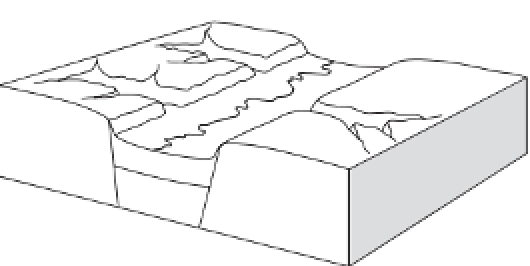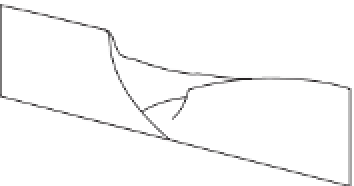Geology Reference
In-Depth Information
If the fault moves repeatedly, the streams are rejuvenated
to form
wineglass
or
funnel valleys
. Some fault scarps
occur singly, but many occur in clusters. Individual mem-
bers of fault-scarp clusters may run side by side for long
distances, or they may run
en échelon
(offset but in
parallel), or they may run in an intricate manner with
no obvious pattern.
A
half-graben
is bounded by a major fault only on one
side (Figure 5.24b). This is called a listric (spoon-shaped)
fault. The secondary or antithetic fault on the other side
is normally a product of local strain on the hanging
wall block. Examples are Death Valley in the Basin and
Range Province of the USA, and the Menderes Valley,
Turkey.
A
horst
is a long and fairly narrow upland raised by
upthrust between two faults (Figure 5.25a). Examples of
horsts are the Vosges Mountains, which lie west of the
Rhine graben in Germany, and the Black Forest Plateau,
which lies to the east of it.
Tilted
or
monoclinal blocks
are formed where a
section of crust between two faults is tilted (Figure 5.25).
The tilting may produce mountains and intervening
basins. In the Basin and Range Province of the western
USA, these are called tilt-block mountains and tilt-block
basins where they are the direct result of faulting.
Rift valleys, horsts, and tilt blocks
Crustal blocks are sometimes raised or lowered between
roughly parallel faults without being subjected to tilting.
The resulting features are called rift valleys and horsts.
A
rift valley
or
graben
(after the German word for a
ditch) is a long and narrow valley formed by subsidence
between two parallel faults (Figure 5.24a). Rift valleys are
not true valleys (p. 232) and they are not all associated
with linear depressions. Many rift valleys lie in zones of
tension in the Earth's crust, as in the Great Rift Valley
of East Africa, the Red Sea, and the Levant, which is the
largest graben in the world. Grabens may be very deep,
some in northern Arabia holding at least 10 km of alluvial
fill. Rift valleys are commonly associated with volcanic
activity and earthquakes. They form where the Earth's
crust is being extended or stretched horizontally, caus-
ing steep faults to develop. Some rift valleys, such as the
Rhine graben in Germany, are isolated, while others lie in
graben fields and form many, nearly parallel structures,
as in the Aegean extensional province of Greece.
Dip-faults and drainage disruption
Fault scarps may disrupt drainage patterns in several
ways. A fault-line lake forms where a fault scarp of
sufficient size is thrown up on the downstream side
of a stream. The stream is then said to be
beheaded
.
Waterfalls form where the fault scarp is thrown up on
the upstream side of a stream. Characteristic drainage
patterns are associated with half-grabens. Back-tilted
drainage occurs behind the footwall scarp related to the
Figure 5.24
Down-faulted structures. (a) Graben. (b) Half-graben.
Source:
After Summerfield (1991, 92)










































































